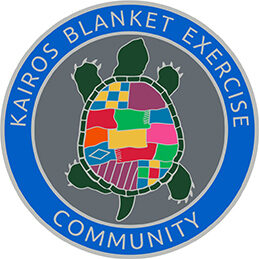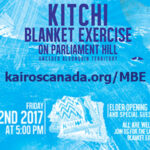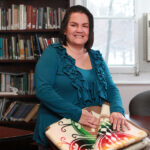In March, I had the privilege of spending two and a half weeks in Alberta and Saskatchewan sharing the KAIROS Blanket Exercise (KBE) with various organizations and communities who were interested in using the exercise to further their understanding of the true history of this land that some call Canada. Beginning in Calgary, passing through Edmonton and Fishing Lake Métis Settlement, all the way to Saskatoon and La Ronge, and finally to Medicine Hat (with some other stops along the way), I was able to see how the KBE can be used to affect change in these communities. While there are many stories that I could share from this KBE tour, this is one that stood out for me as an example of why I continue to be inspired by the transformative work of the KAIROS Blanket Exercise.
In the first week of my journey, I spent a few days at the University of Alberta’s French faculty, Campus Saint-Jean. We organized two KBEs in French for faculty and staff members. They were probably the first French-language KBEs in Edmonton. Although this might have simply been another stop along my way, I was reminded once again of the power of this exercise and of the importance of centering Indigenous practices to make it a safe experience for all participants.
It was late Sunday afternoon, and I had just returned from two days in Fishing Lake Métis Settlement where we were gathering. I was running late, and rushing to get my backpack and the bag of blankets that I brought with me out of the taxi. As I hauled all my baggage with me into the Lacerte Pavilion where the KBE was going to be held, holding the KBE , Lloyd Yellowbird, the Elder’s helper who was going to be with us for the next two days, took one look at me and said “breathe”. I was carrying not only the extra weight of the bag of blankets but another load that comes from navigating unfamiliar cities and extended travel.
Lloyd knew of the emotional energy that is brought forth by the KBE and he wanted to prepare the space in a good way by holding the first ever smudging ceremony in the “Grand Room” in the Pavilion. As the smoke from the locally-grown buffalo sage wafted toward me from the eastern side of the room, I put on my moccasins and stood by the blanket bag waiting for my turn in the circle. After I smudged those feelings away, I unzipped the bag and began to take out the blankets to lay them down on the floor. But Lloyd stopped me and said “these blankets hold history … I can feel the emotions of the people who have walked on them before. We need to smudge these blankets.” Carefully, we began to smudge each and every blanket that we would be using over the next two days, spending particular time on the iconic Hudson’s Bay blanket we would use for the “smallpox blanket”, and the dark grey sheet that we would use for the “residential school blanket”. Once they were laid on the floor, Lloyd smudged around the circumference of the blankets. Cindy Gaudet, a Métis woman and one of the co-organizers of these exercises, then offered a drum song to welcome the grandmothers and grandfathers and the Creator to this space.
The change in energy in the room was palpable; when participants entered the next morning, they were quiet and reflective as they formed a circle around the blankets. That experience with the KBE that day and the next did indeed bring powerful emotions to those blankets: tears were shed, anger and pain were expressed, as well as guilt for not having known about this story before. But at the end of the sharing circle, as we smudged both the blankets and each participant again, each person shared a commitment to learning more. These memories, along with the lingering smell of the buffalo sage smudge on the blankets and the powerful stories they hold, allowed me to feel refreshed and walk with a lighter heart as I continued on my journey.
Now, as I continue to facilitate KBEs in different communities, I pay special attention to the stories, the emotions, and the histories that the blankets hold. I notice and remember people who share in the circle how connected they felt to ‘their blanket’ and the feelings they expressed when it became smaller or was taken away. I thank people who share insights they gained while standing on these blankets. And I will remember to smudge these blankets to honour those emotions that they hold.
I want to say ‘gchi miigwech’ – a big thank you – to all of the amazing people who are KBE champions and who are working to continue to expand this circle. We could not continue our work at the national office without your commitment and support for this important step on the journey of reconciliation.
As we continue to question the celebratory nature of Canada 150 events which don’t acknowledge the colonial underpinnings of the foundation of this country, we can lift up alternative narratives and perspectives which centre Indigenous voices in the retelling of this history. In commemoration of the 20th anniversary of the KAIROS Blanket Exercise and the 2nd anniversary of the release of the Calls to Action, we are once again gathering on unceded Algonquin territory at Parliament Hill for a “Kitchi Blanket Exercise” (Kitchi means ‘really big’ in Anishinaabemowin).
On Friday June 2nd at 5:00pm, in partnership with the Assembly of Seven Generations, we will be hosting the largest KBE ever with facilitators in attendance from all across the northern part of Turtle Island. If you cannot be there in person, urge your friends who are in or near Ottawa to be there on your behalf. There are also other opportunities to show solidarity from wherever you are: check out www.kairoscanada.org/MBE for ideas on how you can be involved outside of Ottawa.
All are welcome. We hope to see you there.
Sara Anderson is the Reconciliation Education Project Coordinator at KAIROS Canada.



